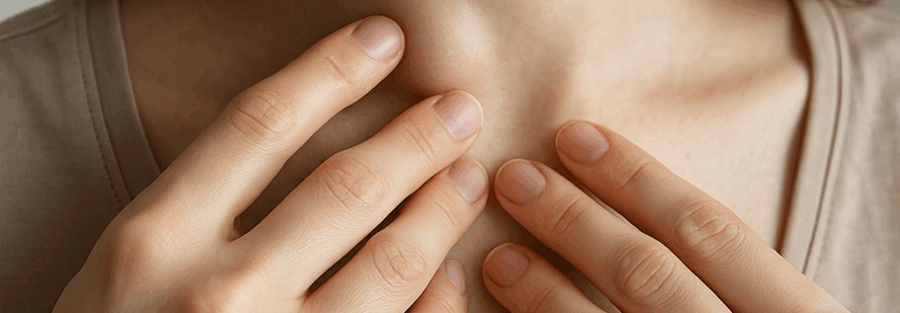Understanding what lumps in the neck, armpit, or groin might mean
“I have a lump on my neck and it hurts. It started a few days ago.”
“I have a lump in my axilla. It has been there this last year. Lately it has grown bigger. It does not hurt. I was told to check it.”
These are common statements heard in my daily clinical practice. While they may sound similar, their underlying causes can vary widely. Lymph node swelling, or lymphadenopathy, can be a benign finding or an indicator that further evaluation is needed. Understanding what lymph nodes are, what they do, and when changes matter is essential for patients.
What are lymph nodes and what do they do?
Lymph nodes are small, bean-shaped structures that are part of the immune system. Their role is to filter lymph fluid, trapping foreign particles such as bacteria, viruses, and abnormal cells. They contain specialized immune cells, including lymphocytes, that help the body recognize and respond to these threats.
They are distributed throughout the body, with clusters located in the neck (cervical), armpits (axillary), groin (inguinal), chest (mediastinal), and abdomen. Most lymph nodes are not visible or palpable unless they become enlarged.
Why do lymph nodes enlarge?
Enlargement of lymph nodes may occur for several reasons. Common causes include:
- Infections, both bacterial and viral, such as a sore throat, tooth abscess, skin infection, or viral illnesses like infectious mononucleosis or cytomegalovirus
- Tuberculosis, which frequently involves cervical or axillary nodes and often presents as a slow, painless swelling that may persist or form a draining sinus
- Autoimmune or inflammatory diseases, such as systemic lupus erythematosus or rheumatoid arthritis
- Cancers, including lymphomas or metastasis from solid tumors
Lymph nodes may enlarge because of the activation and proliferation of immune cells. Sometimes this is a reactive process. In other cases, the lymph node may be infiltrated by abnormal cells.
What is important during physical examination?
The physical characteristics of an enlarged lymph node help guide clinical reasoning. Key points include:
- Size: Nodes smaller than 2 cm are generally considered benign, though this varies by region. In the axillary and inguinal areas, nodes up to 3 cm may still be reactive. In contrast, supraclavicular nodes greater than 1 cm should raise concern.
- Consistency: Soft nodes are often reactive. Rubbery consistency is typical of lymphomas. Very firm or hard nodes may indicate malignancy or granulomatous disease.
- Mobility: Normal nodes are mobile. Nodes fixed to surrounding tissue are more concerning for malignancy.
- Tenderness: Tender nodes are commonly seen in infections. However, lack of pain does not exclude a pathological process.
It is important to note that not all pathologic lymph nodes follow the typical pattern. Some malignant or granulomatous nodes may be painful, and some reactive nodes may be painless. Clinical context is essential.
Why imaging is sometimes necessary
In many cases, imaging helps differentiate between benign and malignant lymphadenopathy. Ultrasound is particularly useful for superficial nodes. CT or MRI may be required when evaluating deep nodes.
Importantly, size alone is not a definitive criterion. Small lymph nodes may still be pathologic based on internal structure. Ultrasound can reveal features such as cortical thickening, absence of the fatty hilum, abnormal vascular patterns, or necrosis.
In selected cases, a biopsy, either fine needle aspiration or excisional, is needed for diagnosis, especially if clinical and imaging findings are suspicious or unclear.
When to consult a doctor
Medical evaluation is required if:
- A lymph node remains enlarged beyond 2 to 4 weeks
- The lump is growing, firm, immobile, or matted with nearby nodes
- There are systemic symptoms such as fever, night sweats, unexplained weight loss, or fatigue
- The node is located in a high-risk area such as the supraclavicular region
While many enlarged lymph nodes are reactive and resolve spontaneously, some require further investigation to rule out significant pathology.
Final considerations
Lymph nodes are central to immune surveillance and often reflect the state of underlying tissues. They may react to infections, inflammation, or neoplasia. A careful clinical examination, supported when necessary by imaging or biopsy, is key to identifying the cause.
Importantly, not all pathologic lymph nodes are large or painless, and not all large nodes are malignant. Interpretation depends on a combination of clinical findings, location, evolution, and diagnostic tools.
Disclaimer:
The information presented in this article is accurate to the best of the author’s knowledge as of the publication date. However, medical knowledge and treatment guidelines are constantly evolving, and new research findings may lead to changes in the information presented here. Readers are encouraged to consult healthcare professionals or refer to the latest guidelines for up-to-date information and personalized medical advice. This article is intended for informational purposes only and is not a substitute for professional medical care.
Reference list:
- Weaver DL. Pathology evaluation of sentinel lymph nodes in breast cancer: protocol recommendations and rationale. Mod Pathol. 2010;23(Suppl 2):S26–32.
- Willard-Mack CL. Normal structure, function and histology of lymph nodes. Exp Toxicol Pathol. 2006;34(5):409–24.
- Cui XW, Jenssen C, Saftoiu A, Ignee A, Dietrich CF. New ultrasound techniques for lymph node evaluation. World J Gastroenterol. 2013;19(30):4850–60.
- Rosenberg SA. Lymph nodes exam findings [Internet]. Stanford Medicine 25; [cited 2025 Jul 30]. Available from: https://stanfordmedicine25.stanford.edu/the25/lymphadenopathy.html
- Ferrer R. Lymphadenopathy: differential diagnosis and evaluation. Am Fam Physician. 1998;58(6):1313–20.
- Habermann TM, Steensma DP. Lymphadenopathy. Mayo Clin Proc. 2000;75(7):723–32.
- Healthline Editorial Team. Lymph nodes: anatomy, diagram and function [Internet]. Healthline; 2015 [cited 2025 Jul 30]. Available from: https://www.healthline.com/human-body-maps/lymph-nodes
- Lymph nodes – Anatomy, function and clinical aspects [Internet]. Kenhub; [cited 2025 Jul 30]. Available from: https://www.kenhub.com/en/library/anatomy/lymph-nodes
- Encyclopaedia Britannica. Lymph node [Internet]. 2018 Aug 13 [cited 2025 Jul 30]. Available from: https://www.britannica.com/science/lymph-node


